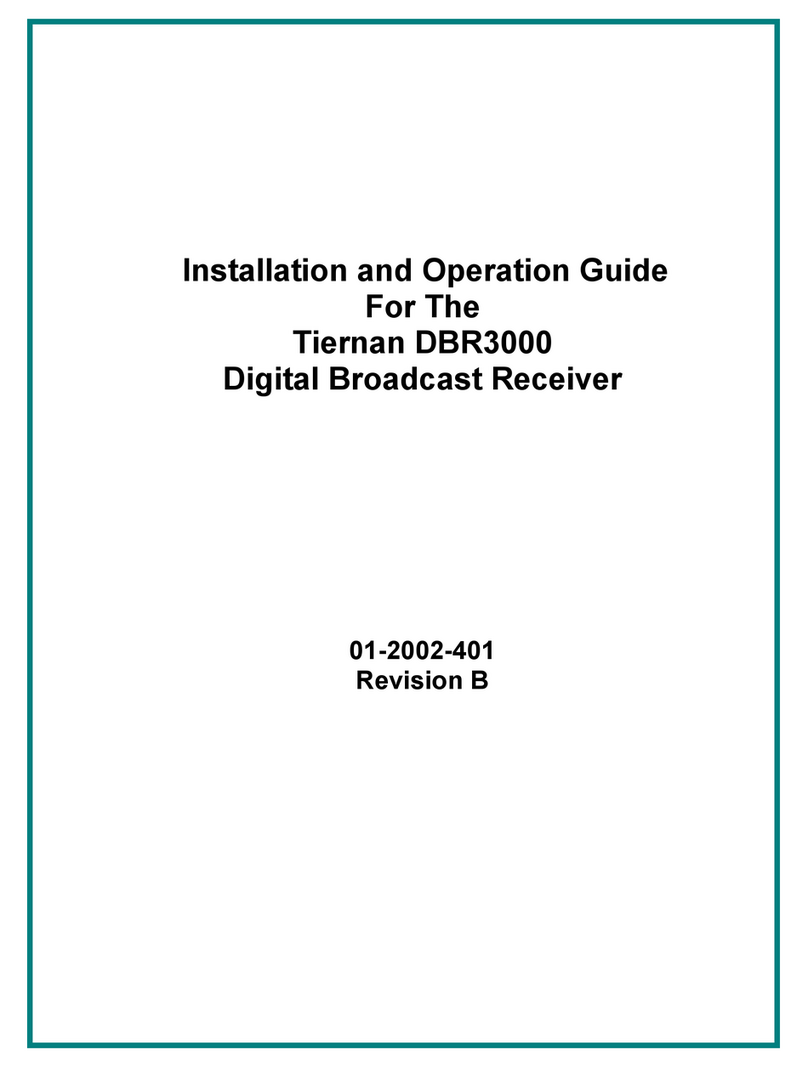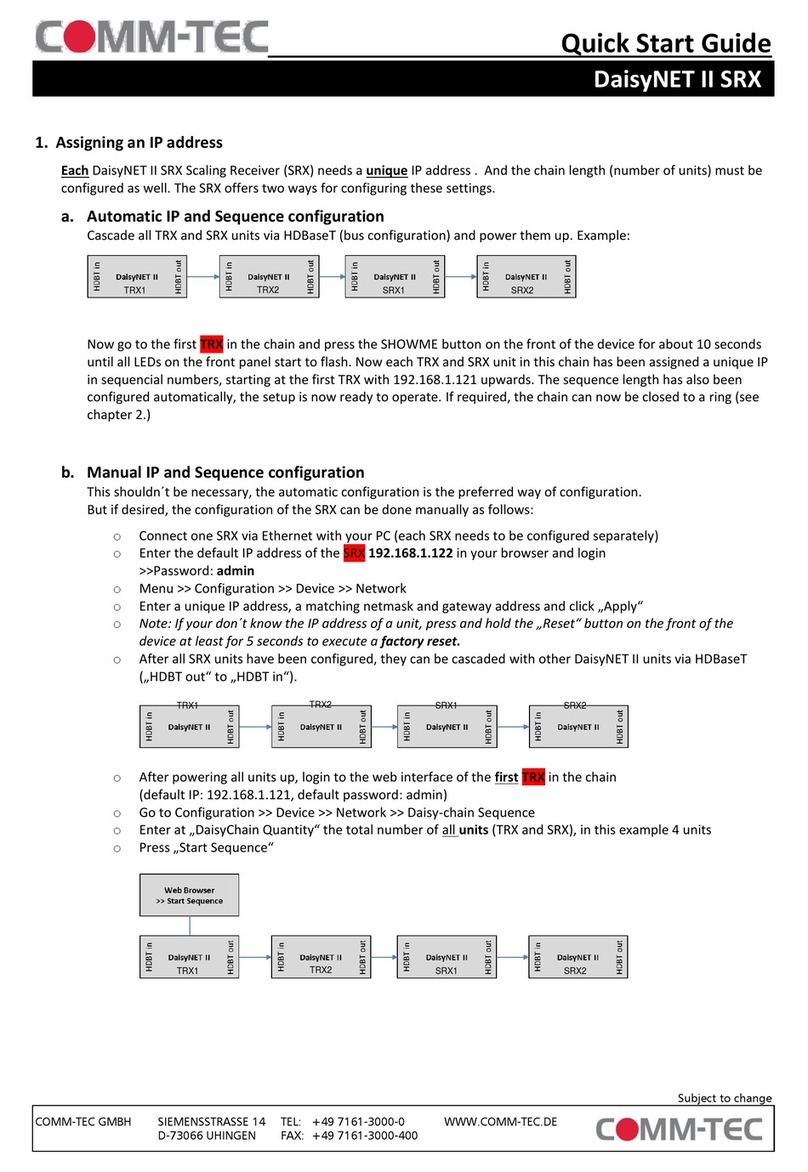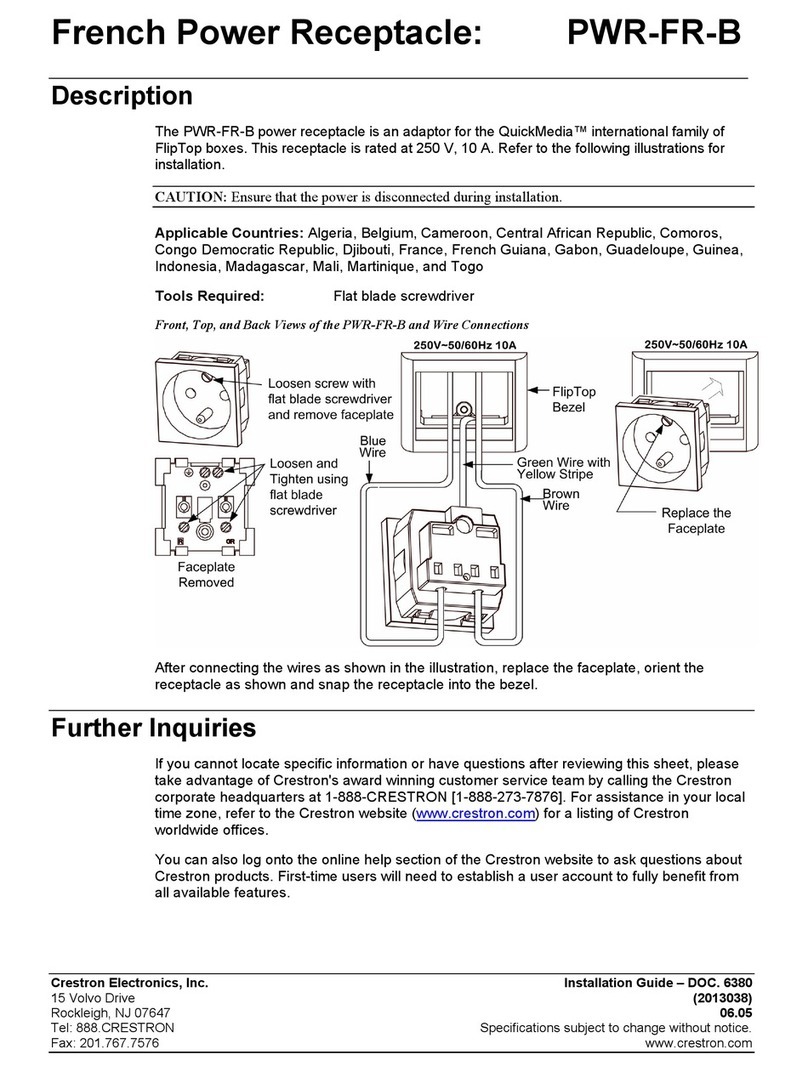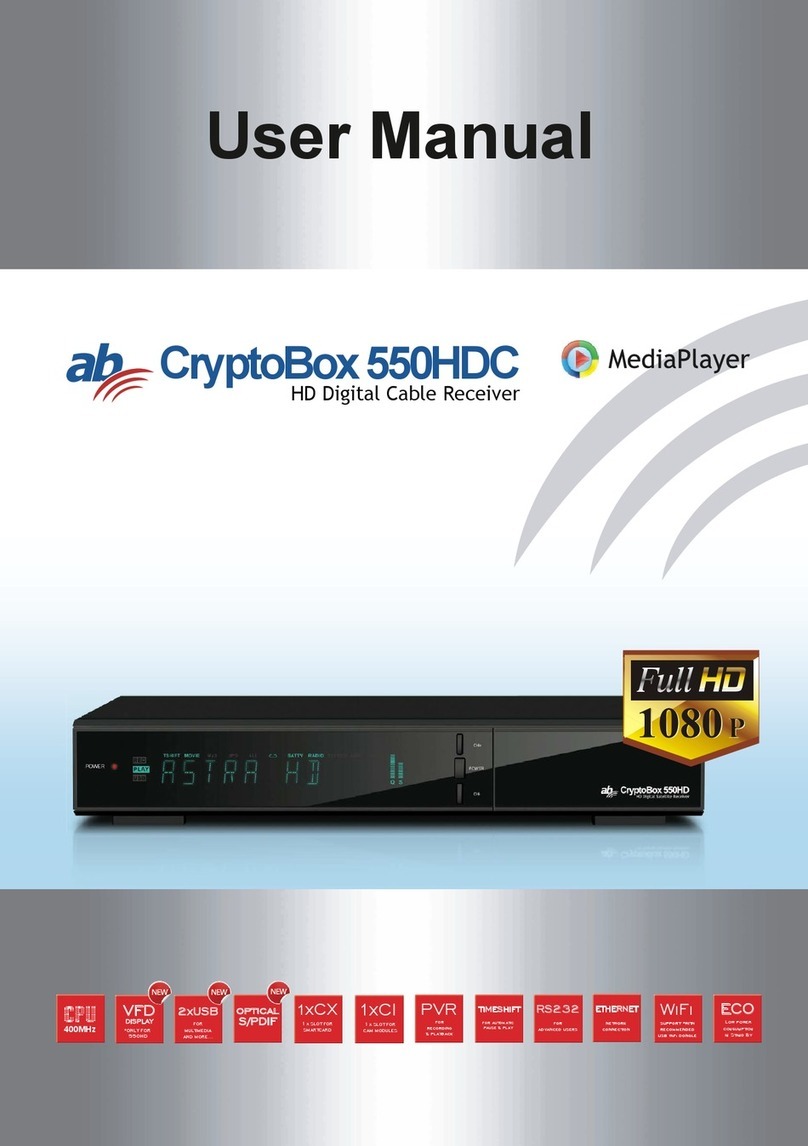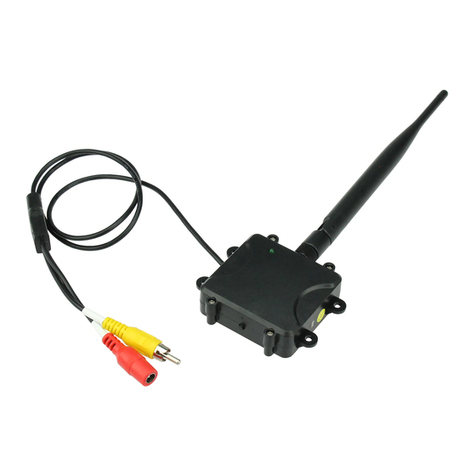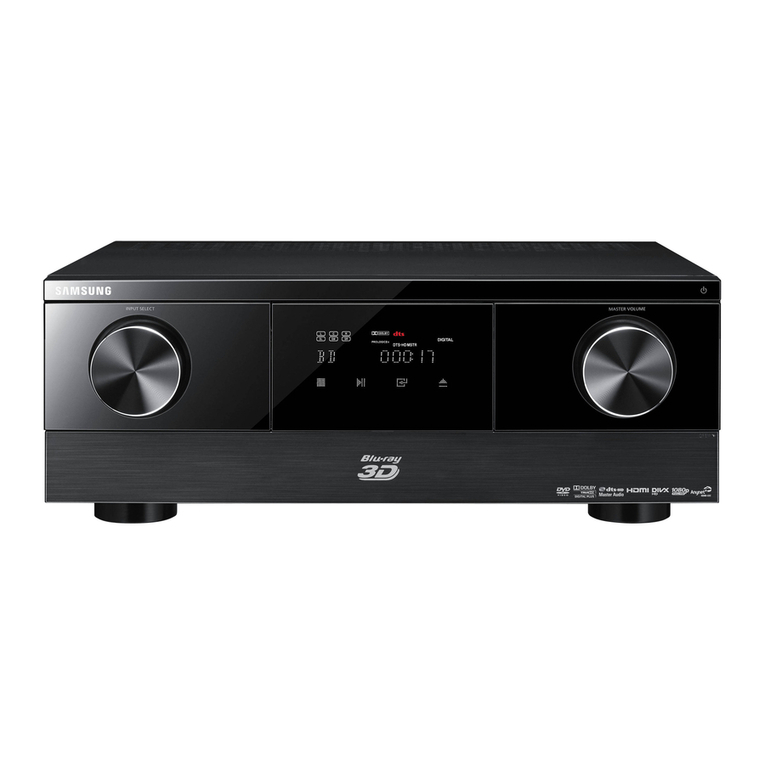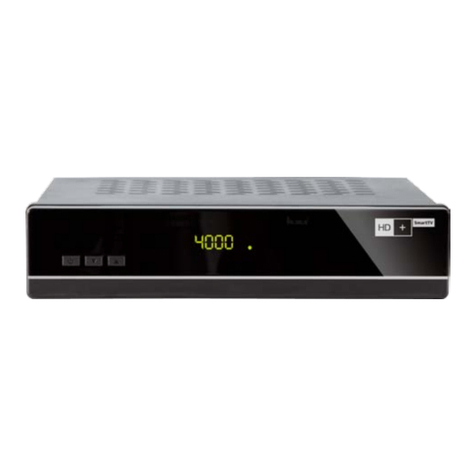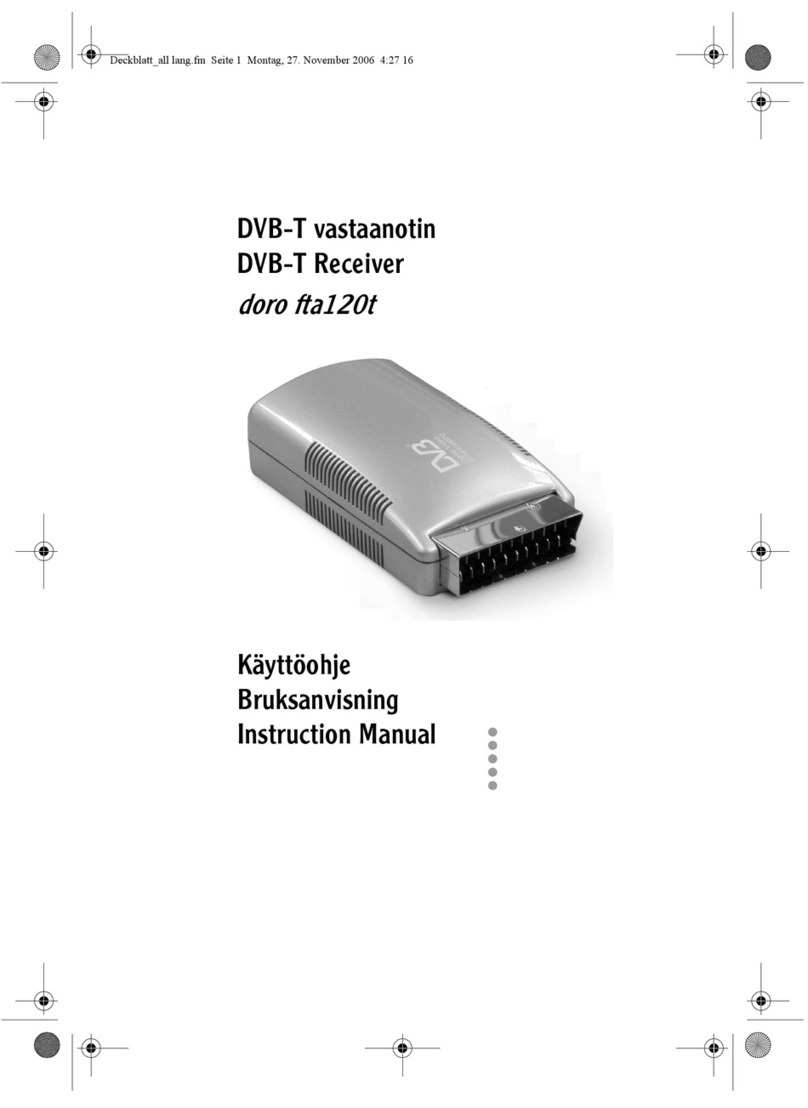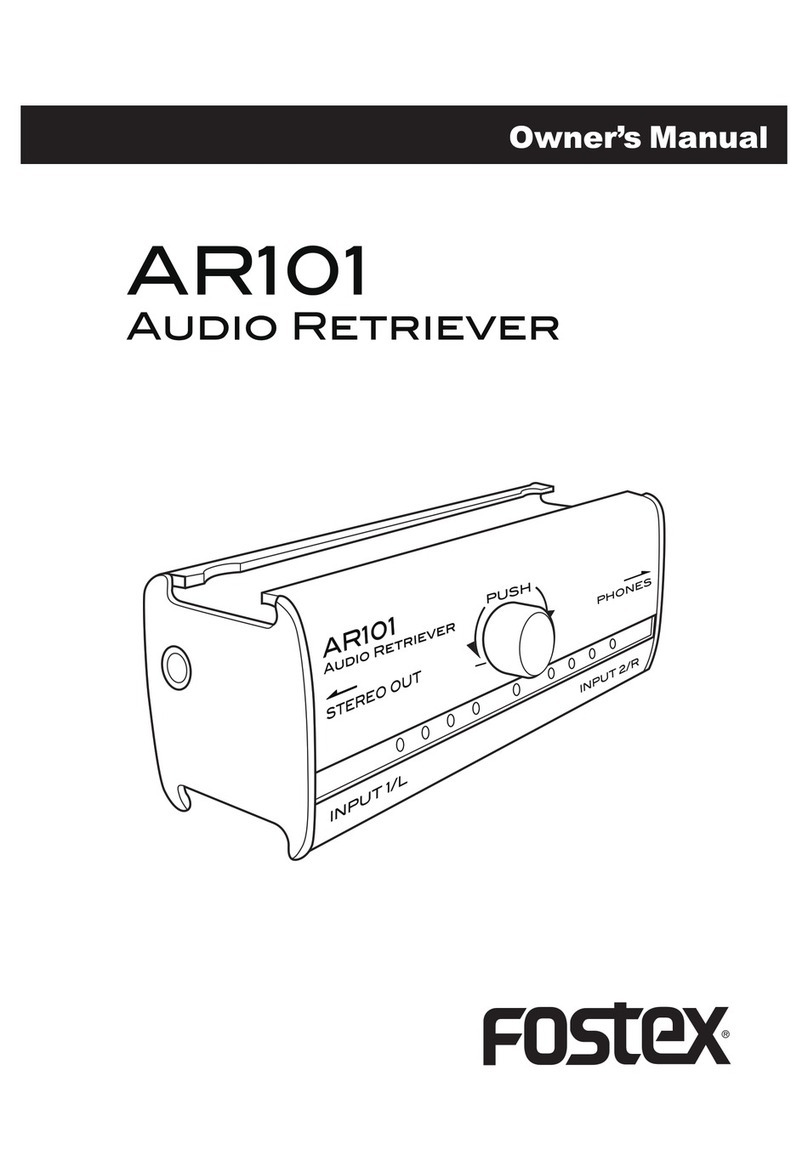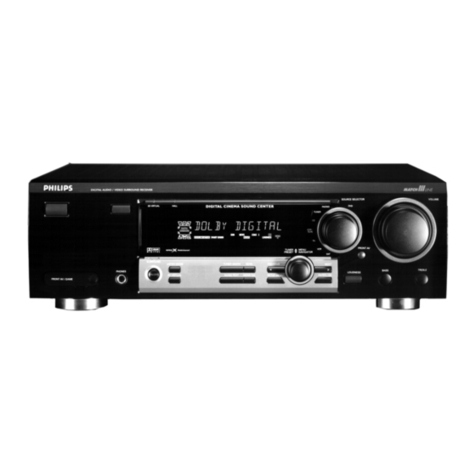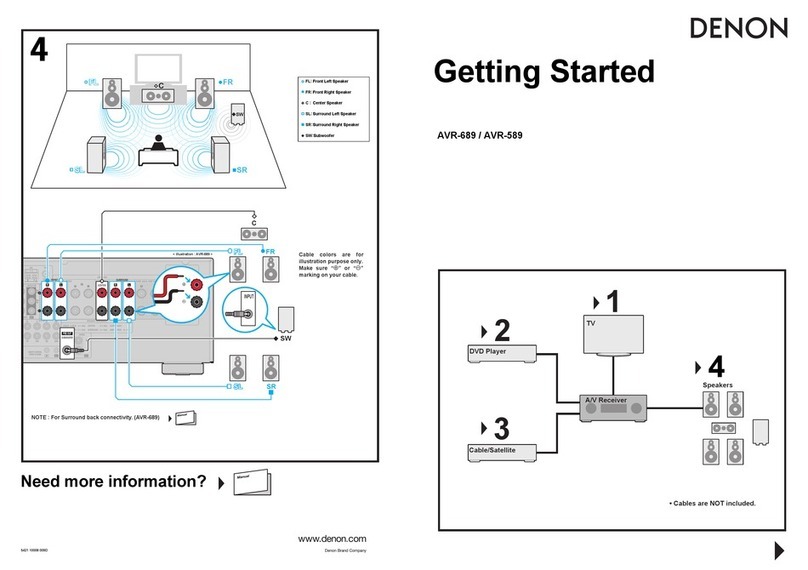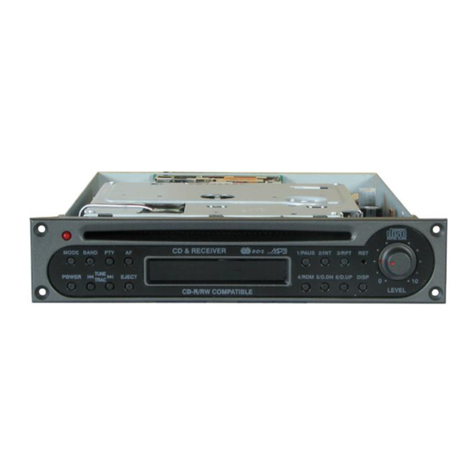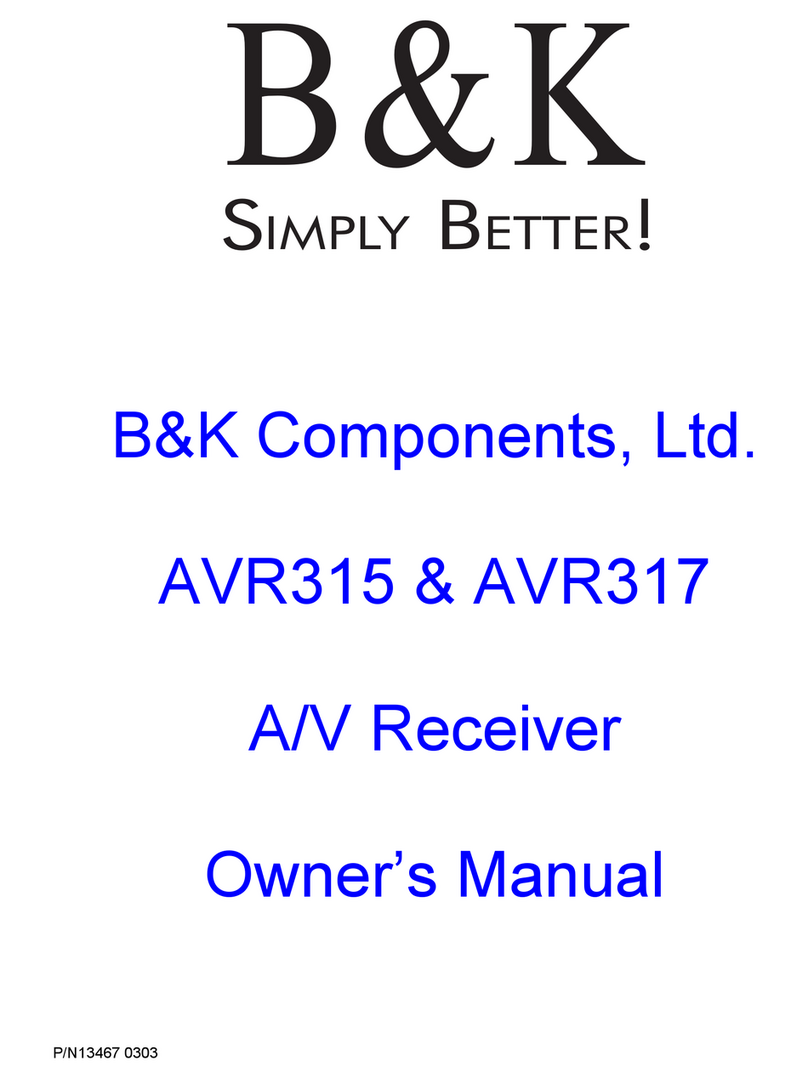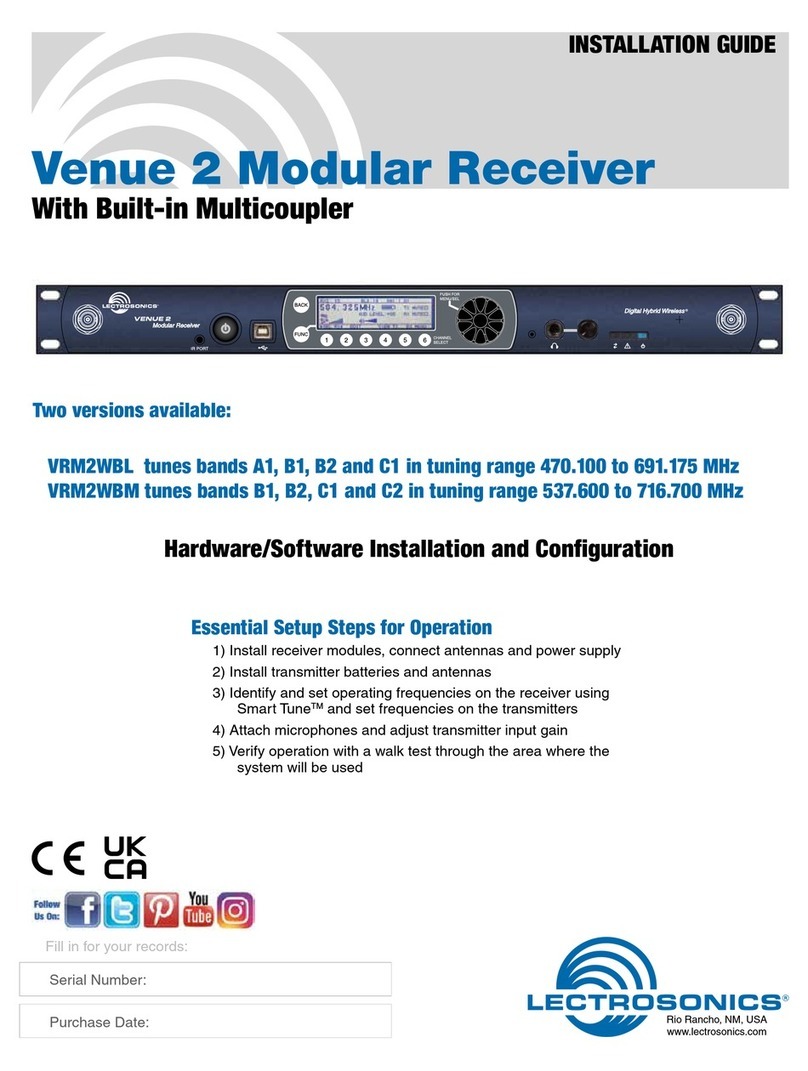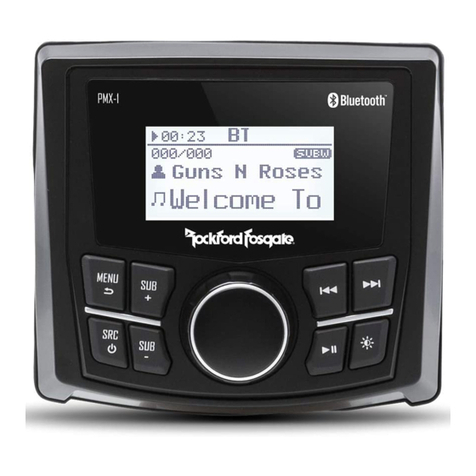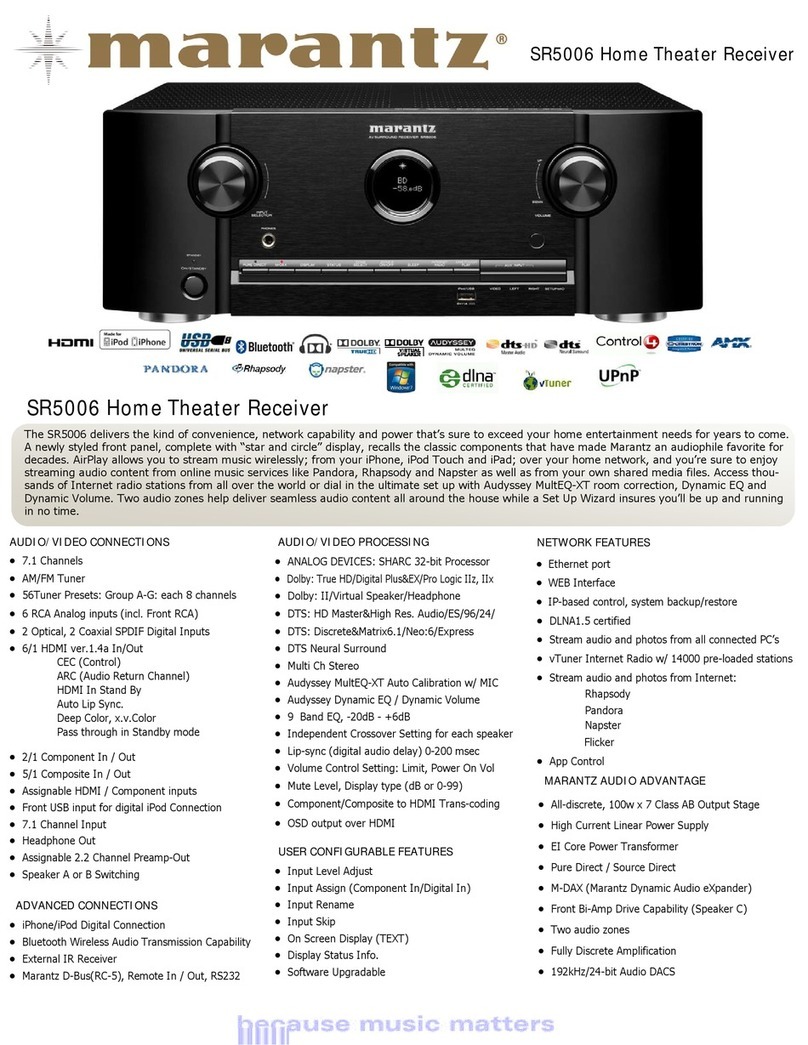Tiernan TDR7 User manual

Communications
IERNAN
T
Previous More
Communications
1 2 3
4 5 6
7 8 9
-0.
Select
Enter
Select Select STATUS FAULT POWER
MPEG-2
Encoder
Previous More
Communications
1 2 3
4 5 6
7 8 9
-0.
Select
Enter
Select Select STATUS FAULT POWER
IRD
MPEG2
TDR7
MPEG–DVB Receiver/Decoder
Copyright 1998-1999 Tiernan Communications, Inc.TDR7 Operator Manual, Revision K, 01/08/99
TPN: 505–002300–0001

ii
Notice
This manual and its contents are proprietary to
Tiernan
Communications, Inc
. (Tiernan) and are intended solely for the
contractual use of its customers for no other purpose than to
install and operate the equipment described herein. This
manual and its contents shall not be used or distributed for any
other purpose and/or otherwise communicated, disclosed, or
reproduced, in any way whatsoever, without prior written
consent of Tiernan.
Only experienced personnel should install and/or operate this
equipment. Prior to installing or operating any of the equipment
or parts thereof, personnel must carefully read and understand
all of the contents of this manual. To properly install and operate
this equipment and/or all parts thereof, personnel must strictly
and explicitly follow all of the instructions in this manual.
FAILURE TO COMPLETELY READ AND FULLY
UNDERSTAND AND FOLLOW ALL OF THE CONTENTS OF
THIS MANUAL PRIOR TO INSTALLING AND/OR OPERATING
THIS EQUIPMENT, OR PARTS THEREOF, MAY RESULT IN
INJURY TO PERSONNEL AND/OR DAMAGE TO THE
EQUIPMENT, OR PARTS THEREOF.
Tiernan does not assume any liability arising out of the
application or use of any products, component parts, circuits,
software, or firmware described herein. Tiernan further does not
convey any license under its patent, trademark, copyright, or
common–law rights nor the similar rights of others. Tiernan
further reserves the right to make any changes in any products,
or parts thereof, described herein without notice.
Copyright ©1998-1999
Tiernan Communications, Inc
.

iii
Restricted Rights
The contents are provided with RESTRICTED RIGHTS. Use,
duplication, or disclosure by the government is subject to
restrictions as set forth in subparagraph (c) (1) (ii) of the
Rights
in Technical Data and Computer Software
[OCT. 1988] clause at
DFARS 252.227–7013
and subparagraphs (a) through (d) of
the
Commercial Computer Software–Restricted Rights
[JUNE
1987] clause at
FAR 52.227–19
, as applicable. Manufacturer is
Tiernan Communications, Inc
., 5751 Copley Drive, San Diego,
CA 92111 U.S.A.
No Warranty
The contents of this manual are provided “as is” without
warranty of any kind, either expressed or implied, including, but
not limited to, the implied warranties of merchantability, fitness
for a particular purpose, and non–infringement.
The contents of this publication could include technical
inaccuracies or typographical errors. Changes are periodically
added to the information herein. These changes will be
incorporated in new editions of this manual. Tiernan may make
improvements and/or changes in the product(s) and/or the
program(s) described in this manual at any time without notice.

iv
Limitation of Liability
In no event will Tiernan be liable for direct, indirect, special,
incidental, economic, cover, or consequential damages arising
out of the use or inability to use the contents even if advised of
the possibility of such damages. Some jurisdictions do not allow
the exclusion or limitation of implied warranties, or the limitation
of liability for incidental or consequential damages, so the above
limitation or exclusion may not apply to you.
For further information on legal and intellectual property
matters, contact
Tiernan Communications Corporate Counsel
.
WARNING: Electric Shock Hazard!
Do Not Open The Equipment!
Service Only by
Tiernan Communications, Inc
.
Gefährliche Spannung!
Öffuen des Gerätes und Service nur dur
Tiernan Communications, Inc
.
The
TDR7 MPEG–2 Integrated Receiver/Decoder
contains no user–serviceable parts. Do
not attempt to service this product yourself. Any attempt to do so will invalidate any and all
warranties.
DANGER!
Electric Shock
Hazard

v
Introduction About this Manual .................................................................ix
Warning Notices ........................................................................................ix
Text Format Conventions .........................................................................xi
Colophon....................................................................................................xii
About the TDR7 Shipping Cartons and Packing Materials...............xiv
Packing Slip ..............................................................................................xiv
Shipping Errors........................................................................................xiv
Cartons and Packing Materials..............................................................xiv
Equipment Repacking Instructions........................................................xv
Chapter 1
TDR7
Overview....................................................................................... 3
Features........................................................................................................3
Option Modules..........................................................................................5
TTO–6000 Option Module........................................................................5
TEA–6000 Option Module ........................................................................ 5
Interfaces......................................................................................................6
Operating Parameters ................................................................................9
Operation within Systems.........................................................................9
Chapter 2 Installing the
TDR7
.............................................................................13
Placement...................................................................................................14
Ventilation..................................................................................................14
Table–Top Placement...............................................................................14
Rack–Mount Placement...........................................................................15
Powering the Unit..................................................................................... 17
AC Power Cords.......................................................................................18
North American Applications ................................................................18
International Applications.......................................................................18
Cabling the TDR7 to the IFL ...................................................................21
Cabling User Equipment to Video Output Ports.................................23
Cabling User Equipment to Audio Output Ports ................................ 24
Cabling User Equipment to Data Output Ports ...................................25
Cabling User Equipment to the Transport Input Port ........................27
Cabling User Equipment to the Transport Output Port .....................28
Installing a Remote Control Device ....................................................... 29
Cabling the Fault Relay Port...................................................................31
Cabling the Teletext Output Port ........................................................... 33

vi
Chapter 3 Using the Control Front Panel.......................................................39
Powering Up..............................................................................................39
Control Front Panel Overview................................................................40
Menus .........................................................................................................41
Main Menu Descriptions .........................................................................44
System Menu .............................................................................................45
Demod Menu.............................................................................................46
Faults Menu...............................................................................................48
Video Menu ...............................................................................................49
Audio Menu...............................................................................................50
Data Menu..................................................................................................51
Control Menu ............................................................................................52
Service Menu .............................................................................................54
PGCA Menu...............................................................................................54
VBI Menu ...................................................................................................56
Version Menu ............................................................................................58
Moving Through Menus..........................................................................59
Changing Parameters...............................................................................62
Correcting Mistakes..................................................................................63
Chapter 4 Using a Remote Control Device Interface ................................69
Remote Control Device Overview..........................................................70
Entering Commands.................................................................................70
Error Messages..........................................................................................74
RCD Commands .......................................................................................75
Audio Decoder Channel A (ADA) and Channel B (ADB)
Commands.................................................................................................76
Decoder Control (DC) Commands.........................................................77
Display Version (DV) Commands..........................................................79
Fault Current (FC) Commands...............................................................80
Fault History (FH) Commands...............................................................81
Fault Relay (FH) Command ....................................................................82
FIFO Status (FS) Command.....................................................................82
Initialization (IN) Commands.................................................................83
Master Controller (MC) Commands......................................................84
PGCA (PGCA) Commands .....................................................................87
QPSK Demodulator (QD) Commands...................................................88
Reset (RE) Command ...............................................................................91
Run–Time Clock (TI) Command............................................................92
System Status (SS) Command.................................................................93
Terminate Diagnostic (TD) Command ..................................................93

vii
Chapter 4
(Continued) User Data Channel A (UDA) and User Data Channel B (UDB)
Commands................................................................................................. 94
VBI Commands (VBI)...............................................................................97
Video Decoder (VD) Commands............................................................98
Chapter 5 Configuring the
TDR7
......................................................................101
DVB Default Settings..............................................................................101
Configuring the TDR7 with the Control Front Panel........................105
Sample Configurations Using the Control Front Panel ....................107
Configuring the TDR7 with a Remote Control Device ..................... 126
Sample Configurations Using an RCD................................................ 128
Chapter 6 Troubleshooting.................................................................................141
BIST Functions ........................................................................................ 141
Demodulator Status................................................................................143
Fault Monitoring.....................................................................................145
Event Time Tagging ...............................................................................145
Current Faults..........................................................................................146
Fault History............................................................................................147
Output Observation ............................................................................... 150
Solving Problems.................................................................................... 151
Appendixes Maintenance.........................................................................................159
Field Software Upgrades....................................................................... 159
Upgrading from the Tiernan Web Site................................................ 159
Equipment Required for the Download.............................................. 160
Equipment Required for Transferring the Files to the TDR7...........160
Upgrading Instructions.......................................................................... 161
Downloading the Software From the Web Site..................................161
Performing a TDR7 Software Upgrade ...............................................162
Upgrading from a Floppy Disk ............................................................ 162
Equipment Required..............................................................................162
Upgrading Instructions.......................................................................... 163
Performing a TDR7 Software Upgrade ...............................................163

viii
Glossary.................................................................................................165
Tiernan Warranty Statement and Technical Support........175
Contacting Tiernan Communications Product Support ...................176
Telephone and Fax Numbers................................................................177
E-mail Address........................................................................................177
Returning Units.......................................................................................178
Tiernan Service Procedure for Out–of–Warranty Repairs................179
TDR7
Specifications.........................................................................181
Return Materials Authorization Form.......................................213

ix
About this Manual
Introduction
This section describes the TDR7 manual conventions and revision
history.
About this Manual
This manual describes the installation, operation, and performance
specifications of the Tiernan Communications, Inc. (Tiernan) TDR7
MPEG–DVB Receiver/Decoder and describes various system issues
which are related to TDR7 operation.
The manual is designed to lead you through unpacking the TDR7 and
completing the setup, mounting, cabling, configuration, and
operational tasks. Additionally, it contains overviews of the system
operation as well as technical specifications and troubleshooting
procedures.
A statement of the Tiernan warranty policy, a list of customer service
contacts, and procedures for returning products should they need
repair are also included.
Warning
Notices Throughout this manual you will find three types of warning notices
that are designed to assist you in identifying important information.
An example of each is provided below.
HAZARD:
The Hazard symbol identifies the possibility of electric shock
when you perform an operation with the
TDR7
or if you do not
use the
TDR7
according to instructions.
DANGER!
Electric Shock
Hazard

x
Introduction
CAUTION:
The Caution symbol identifies an area that requires special
attention to detail or poses the possibility of injury, excluding
injury resulting from electric shock.
NOTE:
The Note symbol identifies points of interest or information
relevant to a procedure or process.
CAUTION!
Please Read
Carefully
NOTE...

xi
About this Manual
Text Format
Conventions This manual contains the text formatting conventions shown below to
help you identify terms defined in the glossary, units of measure, LCD
displays, remote terminal displays, equipment labels, and titles of
publications, companies, company departments, and equipment.
Terms Defined in the Glossary —Terms that appear in bold are
defined in the Glossary.
Units of Measure —Text in
san serif oblique
typeface represents units
of measure.
LCD and Remote Terminal Displays —Textinmonospace typeface
represents characters displayed by the LCD or a remote terminal. An
underscore character (_) in LCD or remote terminal display text
represents a spacebar keystroke.
Equipment Labels —Text in
san serif
typeface represents equipment
labels.
Titles —Text in italic typeface represents formal titles of publications,
companies, company departments, and equipment.

xii
Introduction
Colophon This document was prepared by Tiernan Communications Publications
Department.
Revision Record
TPN: 505–002300–0007
RevisionA, 06/21/96
Initial release of the manual.
RevisionB, 07/09/96
Revised the introduction and installation and startup
information. Added Appendix C.
RevisionC, 07/16/97
Revised the introduction, control front panel, and remote control
information.
RevisionD, 08/28/96
Revised the
TDR7
external connections and the introduction,
installation and startup, control front panel, and system
information. Added Appendix D.
RevisionE, 09/24/96
Revised the introduction and control front panel information.
Revision F, 11/22/96
Revised the
TDR7
external connections and specifications,
Appendixes A and C, and the introduction, installation and
startup, control front panel, remote control, and system
information. Added Appendix E.

xiii
About this Manual
Revision G, 01/10/97
Revised the introduction information and the
TDR7
external
connections.
RevisionH, 08/18/97
Complete revision of the manual, including new menu
descriptions, incorporation of the information from the
appendixes into the appropriate chapters, and the addition of
both a glossary and an index. Compatible with firmware
v. 2.24.02+.
RevisionI, 10/05/97
Revised to include teletext port specifications and cabling
instructions, addition of user data channel and fault relay remote
control commands, updated user data menu options, and minor
editorial changes. Compatible with firmware v. 2.27+.
Revision J, 03/31/98
Updated the
Introduction
and
Warranty
sections, updated the
company address, and completed minor editorial and technical
revisions. Compatible with firmware v. 2.27+.
Revision K, 01/081/99
Redefined the term PGCA. Compatible with firmware v. 2.27+.
Revision Record (Cont.)

xiv
Introduction
About the
TDR7
Shipping Cartons and Packing Materials
Packing Slip Please verify that your company name and address are correct on the
packing slip that is included with your equipment and notify Tiernan
CommunicationsProductSupport if any of the information isnot correct.
Also, please note the purchase order number, reference line, model,
and Tiernan sales order numbers and include them in any
correspondence with Tiernan concerning your order.
Shipping
Errors If any part of your shipment is missing, call Tiernan Communications
Product Support at (619) 587– 0252 or send a fax to (619) 587–0257. For
immediate assistance, call our 24– hour customer service paging
system at (619) 587–0252, extension 500.
Cartons and
Packing
Materials
Note that the factory shipping carton and packing materials are
specially designed to protect the enclosed equipment from the
excessiveshocks andvibrations that canoccur duringshipping.Please
retain the shipping carton and all of the packing materials and use
them to ship the unit to a final destination or to return the unit to
Tiernan for repair. Repacking instructions are listed in the following
section.

xv
About the TDR7 Shipping Cartons and Packing Materials
Equipment
Repacking
Instructions
To repack the TDR7 for shipment to another location or to return the
unit to Tiernan for repair, please use the original shipping carton and
packing materials. Before you begin to repack the equipment, perform
the following inspections:
1. Inspect the shipping carton to ensure that it does not have any
holes punched through itand that all four sides are sturdy and are
firmly attached to the adjacent walls, top, and bottom of the
carton.
2. Ensure that both specially designed suspension frames are
available for use in repacking the equipment. The suspension
frames look like a cardboard frame with a sheet of clear plastic
stretched over the opening.
3. Inspect the two suspension frames to ensure that the cardboard
frames arein one sturdy piece, and the plastic is nottorn or ripped
apart from the frames.
4. If you believe the carton or packing materials will not properly
protect the equipment during shipping, contact Tiernan
Communications Product Support.
CAUTION: Carefully Follow the Repacking Instructions
If the suspension frames are not packed into the shipping carton
as instructed below, the equipment may be severely damaged
during shipping and handling.
CAUTION!
Please Read
Carefully

xvi
Introduction
If you believe the carton and packing materials will properly protect
the equipment during shipment, repack the equipment following the
instructions listed below.
1. Place the first suspension frame into the shipping carton with the
plastic film side facing up and away from the bottom of the
shipping carton. The plastic attached to the suspension frame
must not be touching the bottom of the shipping carton. Whenthe
equipment is placed into the shipping carton, the equipment
should be suspended on the top of the plastic. If the first
suspension frame is placed in the shipping carton with the plastic
film against the bottom of the shipping carton, the equipment will
rest on the bottom of theshipping carton and will not be protected
from shocks and vibrations.
2. Place the equipment into the shipping carton and onto the center
of the plastic suspension frame.
3. Place the second suspension frame into the shipping carton with
the plastic film side facing down towards the top of the
equipment. The plastic attached to the suspension frame must be
placed against the top of the equipment, so that the equipment is
fully suspended between the first suspension frame and the
second suspension frame. When you place the second suspension
frame on top of the equipment, the second suspension frame will
extend higher than the top edge of the shipping carton; however,
when you close the carton, the second suspension frame will
easily fit into the carton. The pressure applied to the second
suspension frame will help hold the equipment in place between
the two suspension frames.
4. Close the carton, and reseal the carton with adhesive tape. Once
the carton is sealed, the packing materials create tension around
theequipmentthat holdsthe equipmentsecurelybetweenthetwo
plastic sheets and safely away from shocks and vibrations.

Chapter 1
TDR7
Overview


3
Chapter 1
TDR7
Overview
TheTDR7 is a DVB–compliant, stand–alone MPEG–2 Integrated
Receiver/Decoder (IRD).
Features The TDR7 field–deployable IRD provides the following outputs:
■NTSC or PAL composite and digital video
■Stereo analog and digital audio
■Synchronous or asynchronous serial user data
■Teletext data (Requires the TTO–6000 option module.)
■Digital video with embedded AES/EBU audio channels
(Requires the TEA–6000 option module.
Previous More
Communications
1 2 3
4 5 6
7 8 9
-0.
Select
Enter
Select Select STATUS FAULT POWER
MPEG-2
Encoder
Previous More
Communications
1 2 3
4 5 6
7 8 9
-0.
Select
Enter
Select Select STATUS FAULT POWER
IRD
MPEG2
Feature Set
DVB and MPEG–2 compliant signal input
Low Noise Block (LNB) controls conformance with North American
industry practice
Professional quality NTSC and PAL video formats
Composite video output on a BNC connector
Digital video output on a BNC connector
Teletext elementary stream data output included in the video output
on a BNC connector (Requires
TT0–6000
option module)
Digital video output with embedded AES/EBU audio channels on a
BNC connector (Requires
TEA–6000
option module)
Full range of pixel and line resolution video resampling

Chapter 14
TDR7 Overview
Option
Modules To expand its operational capabilities, the TDR7 chassis contains one
slot for an option module. Two option modules are available which
allow the TDR7 to provide either teletext or digital video with
embedded ASE/EBU audio channels. The two modules are described
below.
TTO–6000
Option Module
In the PAL video mode, the TTO–6000 allows the TDR7 to process
teletext data contained in a selected service provided by any encoder
that supports DVB–compliant teletext. Teletext data is provided in the
composite video output without impacting the speed at which PGCA
messages are processed. Teletext data parameters are configurable
from the control front panel using an added menu or from a remote
control device using configuration commands.
Variable compressed video and audio bit rates
Variable audio sample rates
Stereo analog audio output in balanced format on a DB–9 connector
Stereo digital audio output in balanced format on a DB–9 connector
Audio decompression of two stereo, joint stereo, dual channel, or four
mono channels
Asynchronous or synchronous user data channel on a DB–15HD
connector
Fully auto–sensing, auto–detecting video and audio decoders
automatically configure parameters based upon information detected
in the selected service.
Non–volatile, field–programmable memory ensures configuration
parameters are retained during power outages and when the unit is
transported.
Feature Set
Table of contents
Other Tiernan Receiver manuals

